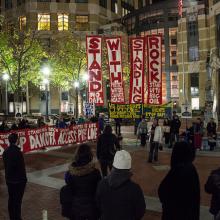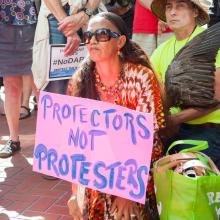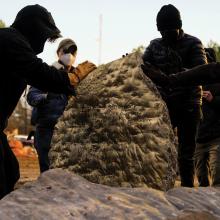Police
One of my favorite passages in the Bible is from in Isaiah 61:1: “The spirit of the Lord God is upon me, because the Lord has anointed me; he has sent me to bring good news to the oppressed, to bind up the brokenhearted, to proclaim liberty to the captives, and release to the prisoners.” Christians will be familiar with this passage as Jesus quotes it when he stands up to read in the synagogue during the early days of his ministry (Luke 4). It’s a passage that gives me some hope for Christianity, since the central character of our religion believed that even the worst-of-the-worst deserve forgiveness.
I was supposed to be taking a writing day this past Monday, but the sound of sirens kept distracting me. Sirens in my Seattle neighborhood are not unusual, but the sirens blared from early morning until noon. By that time, I’d heard 10 or more police cars drive by, which felt different. So, during my lunch break, I resolved to walk down the street to see what all the hullabaloo was about. I figured I wasn’t getting any writing done, so I might as well go investigate.
EVER SINCE I was little, my imagination has been shaped by superhero worlds, lore, and comic and animated adaptations. And while more “realistic” adaptations are the trend on the big screen, what enthralled me about characters such as Batman wasn’t that I thought he could be real; I was tuned instead to the ethos behind the caped crusader.
Superhero stories often seem limitless. At their best, they stretch the imagination to ask what type of world we want to exist and what it would take to get us there, while acknowledging hardships along the way.
Recently, I began a rewatch of the DC Animated Universe: TV shows, feature films, and shorts that aired mainly from 1992 to 2006. These shows were the first to capture my attention and shape my imagination. Batman: The Animated Series was my first love, with Kevin Conroy’s Batman and Mark Hamill’s Joker seared into my consciousness. As I watched, I made a particular note about the moral imagination of these shows: Superheroes in these shows don’t just refuse to kill — a theme recurring across superhero worlds — they refuse to even let anyone die.
Take Season 1, Episode 11 (S1 E11) of Superman: The Animated Series: Lex Luthor’s weapons factory is about to explode, with spilled molten metal splashing about. Lana Lang is hanging by a thread above certain death; so is Lex Luthor, who unintentionally caused this mess in his attempt to kill Superman. But then, at the last moment, Superman bursts forth from under the molten waves, crashing out of the top of the factory just before it explodes, with Lana in one arm and the villain in the other.
It’s a scene that strains credulity. There’s an improbability of timing, a lack of “logic” in doubling back for the person trying to kill you, and the storyteller’s refusal to explain how Superman managed to save the villain. But what’s key here is the insistence, and flaunting, that Superman would save the villain. It doesn’t need an explanation; it’s assumed.
For a while, I was paying attention to how the writers made this subtext believable. Superman saves some villains in hopes they can be rehabilitated, others because they are being used by larger, more villainous characters. Why? The simple answer is that these were shows for families and children. The same reason the comic book’s “League of Assassins” became the TV show’s “Society of Shadows” and villains set out to “destroy” rather than “kill” heroes.
But this death-resisting subtext becomes dialogue in S2 E9 of Superman: The Animated Series when some kids plead with Metallo, a villain disguised as a hero, to save Lois Lane from an exploding volcano. “Superman wouldn’t let anyone die, no matter how bad they were,” the kids protest. “I’m not Superman,” Metallo retorts.
"COP CITY" IS A PLAN to raze 381 acres of forest land in Atlanta and convert it into a massive police training facility that would cost $30 million in public money and $60 million in private. It’s called Cop City because the plans include a mock city inside with things like a playground, school, gas station. All places that cops can train and simulate the things they do. It faced a ton of opposition from a wide range of organizations when it went public in 2021 — and really brought on people at different levels, including climate change and environmental preservation. The private money involved is from a lot of Georgia corporations — Coca-Cola, UPS, Home Depot — and it’s all being run through the Atlanta Police Foundation, the nonprofit entity that the city leased this land to. On the day of the vote, there were 17 hours of public comment against it. The Atlanta City Council approved the plan.
Copaganda refers to any piece of media that portrays police as a necessary social institution. While this can include viral videos of police chatting with neighborhood kids or doing lip-sync battles, the most pervasive examples of copaganda are found in pop culture.
The U.S. prison system is an afront to human dignity and in sharp contrast with God's vision for justice on earth. Christians' commitment to love, hope, and justice should inspire us to work toward abolishing the prison system.
While many Americans, especially white Americans, expect the police to protect their privileges, they often criticize police for the tactics used to protect those privileges. While people should indeed be appalled by racialized police violence, racialized policed violence is actually a symptom of the underlying pandemic of racism — a socially constructed malady designed to protect white privilege.
That’s how fragile black life in the U.S. is. Our risk of being killed by police hinges on little things like the weather.
Black people don’t always end up dead when encountering police. But we almost always end up wounded.
The 39-second cellphone video shot by Bland remained in the hands of investigators until the Investigative Network obtained the video once the criminal investigation closed. Bland’s family said they never saw the video before and now call for Texas officials to re-examine the criminal case against the trooper who arrested Bland, which sparked outrage across the country.
IN MARCH 2015, as video after video of police violence flooded the nation with outrage, grief, and hashtags, an unarmed homeless man named Charly “Africa” Keunang was shot and killed in downtown Los Angeles by the LAPD. In a city still bearing scars from the ’92 uprising that followed the beating of Rodney King on live television, Ferguson and all that followed was but the latest reminder of what happens when black grief is met by a militarized police force.
As a young pastor in downtown LA, I wanted to respond but didn’t know how. After reaching out to local community leaders for wisdom, I called Officer Deon Joseph, a 20-year veteran of the LAPD, adored by some and abhorred by others on Skid Row. Together, we agreed to form a team of pastors, officers, and community members to restore trust between the community and the police. We held a community vigil to honor Brother Africa and hundreds came; the officers in attendance bitterly wept.
“It is an atrocity that an unarmed young man was shot at twenty times in his own backyard and shows the urgent need in these times for intervention against police misconduct. We will call for a complete and thorough investigation into this young man’s death," Rev. Al Sharpton said in a statement.
According to court documents, California Highway Patrol (CHP) worked with and expressed sympathy with the neo-Nazi Traditionalist Workers Party (TWP), treating them as victims and attempted to protect their identity.
During the first few weeks of the Trump administration, we’ve seen increased pressure on Muslim and immigrant communities in the United States.
In the face of these threats, which Marvel superhero might be best equipped to defend the people, ideals, and institutions under attack? Some comic fans and critics are pointing to Kamala Khan, the new Ms. Marvel.

Image via ep_jhu/flickr.com
On Jan. 17 the International Association of Chiefs of Police released their National Consensus Policy on Use of Force, a model policy for officers in the U.S. to follow when considering use of deadly force, reports The Washington Post. The IACP’s model policy includes de-escalation for the first time.
“An officer shall use de-escalation techniques and other alternatives to higher levels of force consistent with his training whenever possible and appropriate before resorting to force and to reduce the need for force,” the policy reads.
There were more than 400 force reports and over 170 officer related shootings in Chicago from January 2011 to April 2016 that. Not only did the department review, investigate and analyze these police documents, procedures, and trainings, they met with city leaders, community organizers, former police officer, rode along with current officers, and heard from over 1000 community members before making this judgement.

Image via Peg Hunter/flickr.com
On Nov. 29 the Morton County Sheriff’s Department announced that it will not allow any more supplies, or potential demonstrators, to reach the campsite where the Dakota Access Pipeline protesters are gathered, reports Reuters. Maxine Herr, a spokesperson for the sheriff’s department, said that retailers have been delivering goods to the protesters, and that from now onward law enforcement “will turn around any of those services.”

Image via Diego G Diaz/Shutterstock.com
President Obama’s words contradict those of Vicki Granado, the spokesperson for Energy Transfer Partners, the company building the Dakota Access Pipeline.
“We are not aware that any consideration is being given to a reroute,” she said, following the publication of President Obama’s interview, “and we remain confident we will receive our easement in a timely fashion.”

Image via Minerva Studio/Shutterstock.com
The incident seems like a straightforward hate crime: Swastikas sprayed in and around the New Jersey home of an Indian-American running for Congress earlier this month.
But the vandalism is steeped in religious and ethnic irony.















